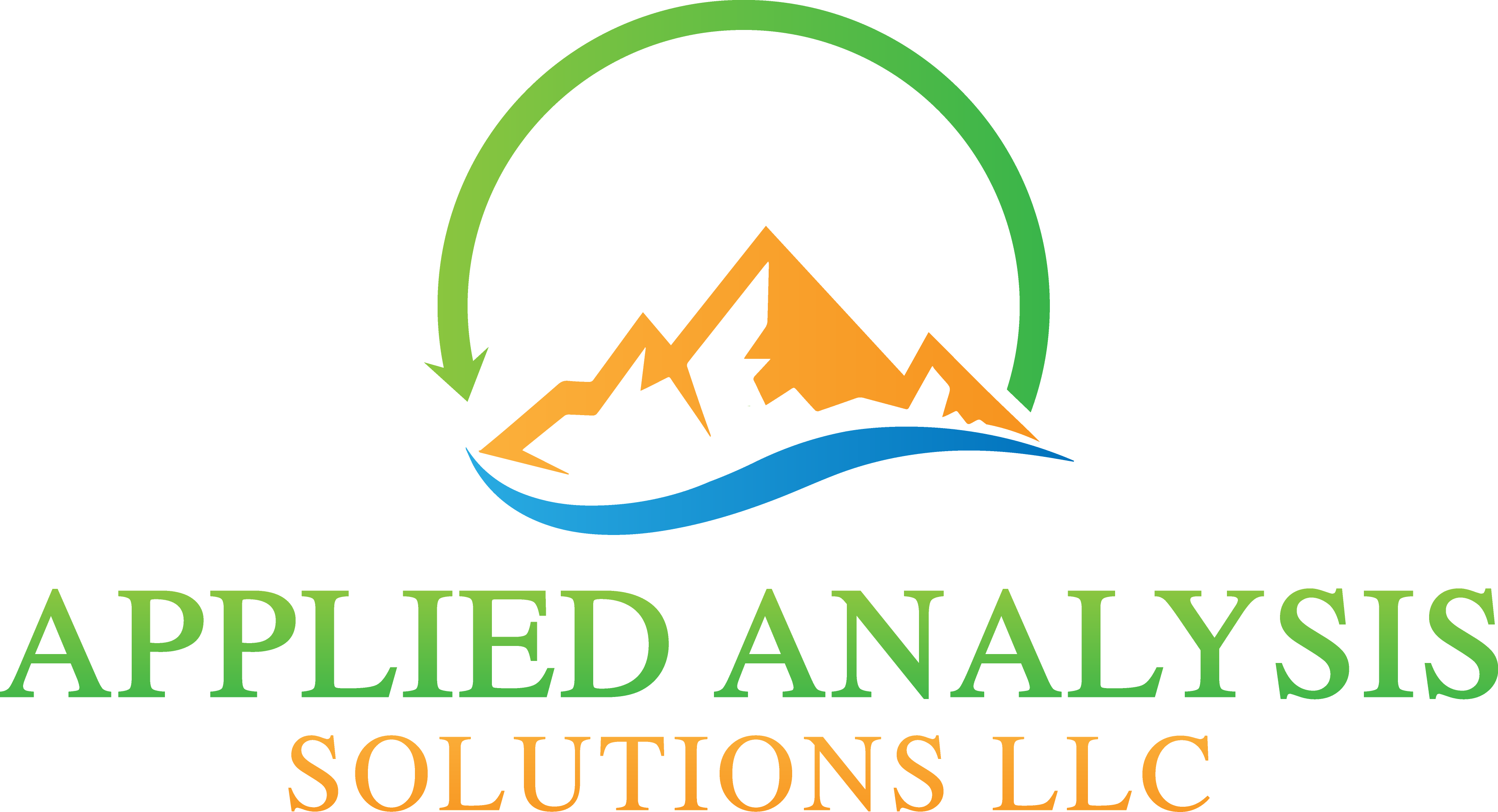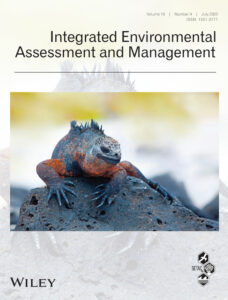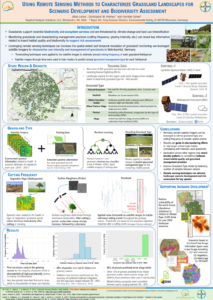2023
Holmes, C.M. (Applied Analysis Solutions, LLC); Pritsolas, J. (Southern Illinois University Edwardsville); Randall Pearson, R. (Southern Illinois University Edwardsville); Butts-Wilmsmeyer, C. (Southern Illinois University Edwardsville); Schad, T. (Bayer CropScience)
In: Applied Sciences, vol. 13, iss. 22, no. 12467, 2023.
Abstract | Links | Tags: 2023, Peer-Reviewed Publication
@article{timeseriesgrassland,
title = {Time-Series Characterization of Grassland Biomass Intensity to Examine Management Change at Two Sites in Germany Using 25 Years of Remote Sensing Imagery},
author = {Holmes, C.M. (Applied Analysis Solutions, LLC) and Pritsolas, J. (Southern Illinois University Edwardsville) and Randall Pearson, R. (Southern Illinois University Edwardsville) and Butts-Wilmsmeyer, C. (Southern Illinois University Edwardsville) and Schad, T. (Bayer CropScience)},
url = {https://www.mdpi.com/2076-3417/13/22/12467, View Online
https://appliedanalysis.solutions/wp-content/uploads/2023/12/Holmes-2023-Time-Series-Characterization-of-Grassland-Biomass-Intensity-to-Examine-Management-Change-at-Two-Sites-in-Germany-Using-25-Years-of-Remote-Sensing-Imagery.pdf, View Document},
doi = {10.3390/app132212467},
year = {2023},
date = {2023-11-17},
urldate = {2023-11-17},
journal = {Applied Sciences},
volume = {13},
number = {12467},
issue = {22},
abstract = {In cultivated landscapes, grasslands are an important land use type for insect life. Grassland management practices can have a significant impact on insect ecology. For example, intense fertilization and frequent cutting can reduce the diversity and abundance of insects by destroying their habitat and food sources. Thus, the quality of grassland habitat for insect development depends on its management intensity. The intensification of grassland production is discussed as one factor contributing to the decline in insect biomass over recent decades. Characterizing grassland changes over time provides one piece to the larger puzzle of insect decline. We analyzed landscape-level trends in grassland biomass near Orbroich and Wahnbachtal in North Rhine-Westphalia, Germany, over a 25-year period. In both areas, pronounced insect biomass decline had been observed. More than 430 Landsat images were used. An image normalization process was developed and employed to ensure that observed changes over time were attributed to grassland changes and not systemic changes inherent within image time series. Distinct clusters of grassland parcels were identified based on intensity and temporal changes in biomass using Normalized Difference Vegetation Index (NDVI) as an indicator. Cluster separability was confirmed using the Transform Divergence method. The results showed clusters having periods of distinct trends in vegetation biomass, indicating changes in grassland agronomic and/or management practices over time (e.g., fertilization, increased silage production). Changes in management practices coincided with regional trends in cultivation as documented by official statistics. We demonstrated the feasibility of using 100+ images over multiple decades to perform a long-term remote sensing analysis examining grassland change. These temporally expansive and spatially detailed trends of grassland change can be included as factors in the multi-variate analysis of insect decline. The methodology can be applied to other geographic areas. Such improved insights can support informed landscape design and cultivation patterns in relation to insect ecology and the broader context of biodiversity enhancement.},
keywords = {2023, Peer-Reviewed Publication},
pubstate = {published},
tppubtype = {article}
}
Insinga, L. (Applied Analysis Solutions, LLC); Kay, S. (Pyxis Regulatory Consulting, Inc); Desmarteau, D. (Waterborne Environmental, Inc.)
10.10.2023.
Abstract | Links | Tags: 2023, EMPM, Presentation
@misc{EMPM2023pwc,
title = {PWC-PREP Tool: A user-friendly tool to facilitate preparation of label-compliant Pesticide in Water Calculator (PWC) batch input files},
author = {Insinga, L. (Applied Analysis Solutions, LLC) and Kay, S. (Pyxis Regulatory Consulting, Inc) and Desmarteau, D. (Waterborne Environmental, Inc.) },
url = {https://appliedanalysis.solutions/wp-content/uploads/2024/05/EMPM-2023-PWC-Prep-Tool.pdf, View Presentation},
year = {2023},
date = {2023-10-10},
urldate = {2023-10-10},
abstract = {The USEPA’s Pesticide in Water Calculator (PWC) simulates pesticide applications to land surfaces and subsequent transport to and fate in waterbodies. When using PWC, one significant issue is accurately modeling pesticides as they typically have diverse uses and restrictions that vary based on the use site, region, and time of year. These uses and restrictions are codified in the product label and can be highly interrelated with many permutations of potential applications. Therefore, defining conservative yet label-compliant use-patterns can be difficult and time consuming. Failure to account for all labeled agronomic restrictions including total pesticide amount applied and number of application limitations on an annual and interval specific (e.g., pre-emergence or post-emergence) basis, as well as multiple application rates with rate-specific limitations (i.e., number of applications and temporal windows), minimum reapplication intervals, and pre-harvest intervals can lead to modeling of non-label-compliant or unrealistic application use patterns. In addition, efforts to ensure modeling is conservative (e.g., simulation of applications during wettest months of the year for ESA assessments, or maximizing total amount applied in a year) can significantly complicate application date assignment logic. To address these difficulties, the Generic Endangered Species Task Force (GESTF) has developed the PWC-PREP Tool to facilitate batch file preparation for PWC modeling. Specifically, the PWC-PREP Tool features a robust algorithm that generates label-compliant application dates and rates for a wide variety of use sites, regions, and chemicals. Leveraging a graphical user interface, the tool is highly configurable and allows the user to control modeling parameters related to application methods, drift factors, agronomic restrictions, and date-assignment. The PWC-PREP Tool to has been successfully used to efficiently parameterize a national set of PWC runs (n > 30,000) that follow label instructions in a manner that is transparent and can be repeated.},
keywords = {2023, EMPM, Presentation},
pubstate = {published},
tppubtype = {presentation}
}
Schad, T. (Bayer AG); Bub, S. (Rheinland‐Pfälzische Technische Universität); Wang, M. (WSC Scientific GmbH); Holmes, C.M. (Applied Analysis Solutions, LLC); Kleinmann, J. (WSC Scientific GmbH); Hammel, K. (Bayer AG); Ernst, G. (Bayer AG); Preuss, T.G. (Bayer AG)
A spatiotemporally explicit modeling approach for more realistic exposure and risk assessment of off‐field soil organisms Journal Article
In: Integrated Environmental Assessment and Management, vol. 20, iss. 1, pp. 263-278, 2023.
Abstract | Links | Tags: 2023, Peer-Reviewed Publication
@article{2023modeling,
title = {A spatiotemporally explicit modeling approach for more realistic exposure and risk assessment of off‐field soil organisms},
author = {Schad, T. (Bayer AG) and Bub, S. (Rheinland‐Pfälzische Technische Universität) and Wang, M. (WSC Scientific GmbH) and Holmes, C.M. (Applied Analysis Solutions, LLC) and Kleinmann, J. (WSC Scientific GmbH) and Hammel, K. (Bayer AG) and Ernst, G. (Bayer AG) and Preuss, T.G. (Bayer AG)},
url = {https://setac.onlinelibrary.wiley.com/doi/10.1002/ieam.4798, View Online
http://appliedanalysis.solutions/wp-content/uploads/2023/08/Schad-2023-IEAM-A-spatiotemporally-explicit-modeling-approach-for-more-realistic-exposure-and.pdf, View Document},
doi = {https://doi.org/10.1002/ieam.4798},
year = {2023},
date = {2023-06-21},
urldate = {2023-06-21},
journal = {Integrated Environmental Assessment and Management},
volume = {20},
issue = {1},
pages = {263-278},
abstract = {Natural and seminatural habitats of soil living organisms in cultivated landscapes can be subject to unintended exposure
by active substances of plant protection products (PPPs) used in adjacent fields. Spray‐drift deposition and runoff are
considered major exposure routes into such off‐field areas. In this work, we develop a model (xOffFieldSoil) and associated
scenarios to estimate exposure of off‐field soil habitats. The modular model approach consists of components, each ad-
dressing a specific aspect of exposure processes, for example, PPP use, drift deposition, runoff generation and filtering,
estimation of soil concentrations. The approach is spatiotemporally explicit and operates at scales ranging from local edge‐
of‐field to large landscapes. The outcome can be aggregated and presented to the risk assessor in a way that addresses the
dimensions and scales defined in specific protection goals (SPGs). The approach can be used to assess the effect of
mitigation options, for example, field margins, in‐field buffers, or drift‐reducing technology. The presented provisional
scenarios start with a schematic edge‐of‐field situation and extend to real‐world landscapes of up to 5 km × 5 km. A case
study was conducted for two active substances of different environmental fate characteristics. Results are presented as a
collection of percentiles over time and space, as contour plots, and as maps. The results show that exposure patterns of off‐
field soil organisms are of a complex nature due to spatial and temporal variabilities combined with landscape structure and
event‐based processes. Our concepts and analysis demonstrate that more realistic exposure data can be meaningfully
consolidated to serve in standard‐tier risk assessments. The real‐world landscape‐scale scenarios indicate risk hot‐spots that
support the identification of efficient risk mitigation. As a next step, the spatiotemporally explicit exposure data can be
directly coupled to ecological effect models (e.g., for earthworms or collembola) to conduct risk assessments at biological
entity levels as required by SPGs. Integr Environ Assess Manag 2023;00:1–15. © 2023 Applied Analysis Solutions LLC and
WSC Scientific GmbH and Bayer AG and The Authors. Integrated Environmental Assessment and Management published by
Wiley Periodicals LLC on behalf of Society of Environmental Toxicology & Chemistry (SETAC)},
keywords = {2023, Peer-Reviewed Publication},
pubstate = {published},
tppubtype = {article}
}
by active substances of plant protection products (PPPs) used in adjacent fields. Spray‐drift deposition and runoff are
considered major exposure routes into such off‐field areas. In this work, we develop a model (xOffFieldSoil) and associated
scenarios to estimate exposure of off‐field soil habitats. The modular model approach consists of components, each ad-
dressing a specific aspect of exposure processes, for example, PPP use, drift deposition, runoff generation and filtering,
estimation of soil concentrations. The approach is spatiotemporally explicit and operates at scales ranging from local edge‐
of‐field to large landscapes. The outcome can be aggregated and presented to the risk assessor in a way that addresses the
dimensions and scales defined in specific protection goals (SPGs). The approach can be used to assess the effect of
mitigation options, for example, field margins, in‐field buffers, or drift‐reducing technology. The presented provisional
scenarios start with a schematic edge‐of‐field situation and extend to real‐world landscapes of up to 5 km × 5 km. A case
study was conducted for two active substances of different environmental fate characteristics. Results are presented as a
collection of percentiles over time and space, as contour plots, and as maps. The results show that exposure patterns of off‐
field soil organisms are of a complex nature due to spatial and temporal variabilities combined with landscape structure and
event‐based processes. Our concepts and analysis demonstrate that more realistic exposure data can be meaningfully
consolidated to serve in standard‐tier risk assessments. The real‐world landscape‐scale scenarios indicate risk hot‐spots that
support the identification of efficient risk mitigation. As a next step, the spatiotemporally explicit exposure data can be
directly coupled to ecological effect models (e.g., for earthworms or collembola) to conduct risk assessments at biological
entity levels as required by SPGs. Integr Environ Assess Manag 2023;00:1–15. © 2023 Applied Analysis Solutions LLC and
WSC Scientific GmbH and Bayer AG and The Authors. Integrated Environmental Assessment and Management published by
Wiley Periodicals LLC on behalf of Society of Environmental Toxicology & Chemistry (SETAC)
LaRoe, J. (Applied Analysis Solutions, LLC); Holmes, C.M. (Applied Analysis Solutions, LLC); Schad, T. (Bayer AG)
04.30.2023.
Links | Tags: 2023, Poster, SETAC Europe
@misc{2023EUScenario,
title = {Using Remote Sensing Methods to Characterize Grassland Landscapes for Scenario Development and Biodiversity Assessment},
author = {LaRoe, J. (Applied Analysis Solutions, LLC) and Holmes, C.M. (Applied Analysis Solutions, LLC) and Schad, T. (Bayer AG)},
url = {https://appliedanalysis.solutions/wp-content/uploads/2023/08/SETAC-EU-2023-GrasslandPoster-final.pdf, View Poster},
year = {2023},
date = {2023-04-30},
urldate = {2023-04-30},
keywords = {2023, Poster, SETAC Europe},
pubstate = {published},
tppubtype = {presentation}
}
Holmes, C.M. (Applied Analysis Solutions, LLC); Maltby, L. (The University of Sheffield); Sweeney, P. (Syngenta); Thorbek, P. (BASF); Otte, J.C. (BASF); Marshall, S. (Consultant, UK)
04.30.2023.
Links | Tags: 2023, Poster, SETAC Europe
@misc{EU2023Heterogeneity,
title = {Heterogeneity in Biological Assemblages and Exposure in Chemical Risk Assessment: Exploring Capabilities and Challenges in Methodology with Two Landscape-Scale Case Studies},
author = {Holmes, C.M. (Applied Analysis Solutions, LLC) and Maltby, L. (The University of Sheffield) and Sweeney, P. (Syngenta) and Thorbek, P. (BASF) and Otte, J.C. (BASF) and Marshall, S. (Consultant, UK)},
url = {https://appliedanalysis.solutions/wp-content/uploads/2023/08/SETAC-EU-2023-4.01.P-Mo263-Geo-ref-TF.pdf, View Poster},
year = {2023},
date = {2023-04-30},
urldate = {2023-04-30},
keywords = {2023, Poster, SETAC Europe},
pubstate = {published},
tppubtype = {presentation}
}





